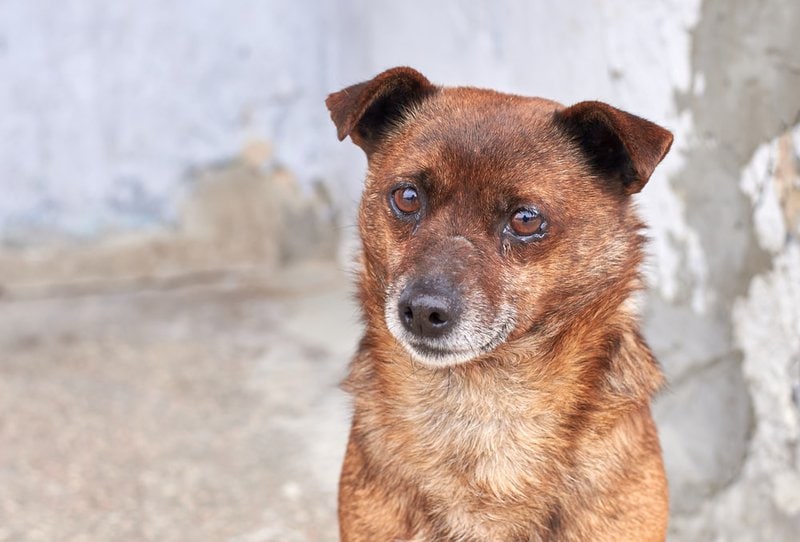Have you noticed sometimes a stream of tears flowing down your pooch’s eyes? Are they expressing their emotions or are they in pain? It is instinctual for us humans to comfort somebody when we see someone crying, but is it the same for our furry friends? Can dogs cry?
Yes, dogs cry tears, but not in the way we humans cry when we are feeling overly emotional. Dogs have a watery discharge or tears probably because of an underlying condition in their tear ducts like an eye infection, allergies, or simply clearing out the dirt blocking their vision.
Dogs express their pain, happiness, and sadness in other ways but do not cry out tearfully. Animals would usually make distress calls when they are separated from their herd or whimper when they are in pain.
In this article, we will try to tackle the reasons why some dogs seem to tear up and the things we can do to manage the health issues that are causing the problem.
Is It Normal For A Dog To Cry?

A small amount of tearing from time to time may be acceptable, but if it is accompanied by a yellowish discharge or smell and happens frequently, then you should have it checked by the veterinarian.
Normally, a dog’s eye should not have a discharge since the dog’s tears drain through the back of the nose and throat, where the nasolacrimal ducts are located.
Are Certain Breeds Prone To Tearing Or Eye Discharge?
Yes, brachycephalic breeds like the Pug, Shih-Tzu, and Pekingese are more vulnerable to eye discharge. This is because of their shallow eye sockets and short noses, causing tears to spill out onto the fur around their eyes.
Cocker Spaniels and Poodles are also commonly affected by a lack of openness in the lacrimal duct since birth, known as imperforate puncta. These dogs can have visible brown staining down the side of their face.
Why Is My Dog Crying Tears?

There may be several reasons why you might notice your dog seems to have watery eyes. Dogs have tear ducts just like we do, but normally, the tears are drained through the back of their nose and throat instead of tearing out in front.
Here are some possible reasons why dogs cry tears:
Allergies
An allergic reaction is one of the main reasons your dog would produce tears in its eyes. Smoke, pollen, dust, strong detergents, or food ingredients could be a source of that allergy.
If you suspect a food allergen, an elimination diet could be suggested by the veterinarian to find out what food is causing the adverse reaction.
Also, if other signs of an allergy are present, like swelling and itching around the eyes and nose, skin rashes or redness, sudden wheezing or shortness of breath, and inflammation, then the teary eyes could be caused by an allergen.
The veterinarian may very well prescribe an antihistamine to correct the problem.
Blockage Of Tear Ducts
Normally, a dog’s eye would produce tears for lubrication and would drain down their throats through the nasolacrimal ducts, which are located underneath their eyes and nose.
When the ducts are blocked, then the tears would drain out front, which is a condition known as epiphora. Common signs of epiphora include a damp face, reddish staining on the fur beneath the eyes, odor, and skin irritation.
Possible causes of epiphora are an anatomical abnormality in their eyelashes and eyelids, corneal ulcers, and glaucoma.
It can be treated through surgery by opening up the ducts if it fails to open during the puppy’s development, or it can be flushed by widening the ducts if it is caused by an allergy or infection.
For a lot of dogs that have this condition, the problem is usually cosmetic and does not pose any significant health problems.
Eye Infection
If you notice that the tear discharge is yellowish, mucous, or bloody, then it could be a sign of an eye infection. Other signs to look out for are redness in their eyes, swelling, squinting due to sensitivity to light, and a smelly discharge.
Possible causes of an eye infection include conjunctivitis, which is the inflammation of the mucous membrane inside their eyelids, causing it to turn red.
Another cause could be uveitis or inflammation of the uvea, which includes the iris, ciliary body, and choroid. Common causes of uveitis are diabetes, high blood pressure, the distemper virus, and eye tumors.
A combined treatment of antibiotics, pain relievers, and ophthalmic ointment can be prescribed by the veterinarian to alleviate the swelling or inflammation.
Scratched Cornea
Your dog’s playfulness and inquisitiveness could sometimes be a reason for its cornea getting scratched or poked accidentally. More so if it likes playing around thick undergrowth or chasing around scared cats.
This would surely cause its eyes to tear up excessively. Other signs include constant rubbing and blinking of the eyes, swelling, or holding one eye closed.
A lot of cases are usually minor and can be treated with an eye drop and painkillers. It is always advised to have the veterinarian check the eyes for any possible major damage.
Entropion
This is an ocular condition when the eyelids roll inward. This would cause the eyelashes to rub against their eye covering, leading to irritation, inflammation, and possible infection.
Signs of entropion include constant rubbing and squinting of the eyes, excessive tearing, discharge, and swelling.
Surgery is the best option, but artificial tears and lubricating ointments can help relieve the condition.
Dirt Or Debris
Most usually, a speck of dirt or dust is the simple explanation for your dog tearing up. A lot of times, the tearing would stop after the irritant had been removed by the tears.
You can also opt to wipe around their eyes with a soft, damp cloth to remove any dirt or flush it with a dog-approved eyewash. Be careful, though, not to wipe the eye itself and allow it to come into contact with the eyewash.
For larger and embedded debris, it is recommended that you take your dog to the veterinarian to prevent any accidental mishandling.
How Do You Know When Your Dog Is Crying?
Dogs have feelings just like we humans. They can experience pain, sadness, loss, and grief. They are just as emotionally intelligent as we are, but they express it in their own unique ways.
Whining, Whimpering, Or Howling
Dogs instinctively learn to whine or whimper when they are just newborn puppies as a way to communicate with their mother. They are born without sight, and they use whimpering to signal that they need to be fed.
They continue this behavior into adulthood when they need to communicate something to you, like asking for more food, wanting to play, or asking to be taken outside.
Shaking, Trembling, Or Shivering
There are several reasons why your dog may be showing these behaviors. It could be due to pain, fear, excitement, or simply feeling cold.
In some instances, it could be a sign of something more serious like kidney disease, viral infection, or brain disease.

Hiding
Anxious and sensitive dogs may exhibit this behavior as a way of feeling safe. You may see them hiding under the bed or in some corner where they can feel secure.
The fear of getting reprimanded by their owner or an alarm suddenly going off could trigger a dog to find a safe place.
Refusing Eye Contact
Sometimes a dog may ignore you and refuse to follow a command, and even avoid eye contact. This could be a sign that it may be upset with you or their environment.
It is best to let your dog cool down for a bit and use a gentle voice when it is ready to interact with you again.





